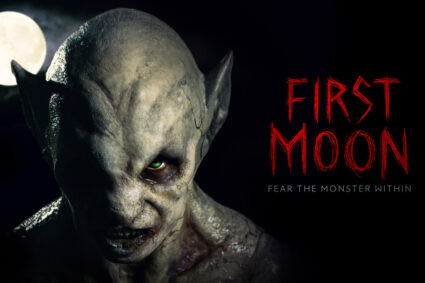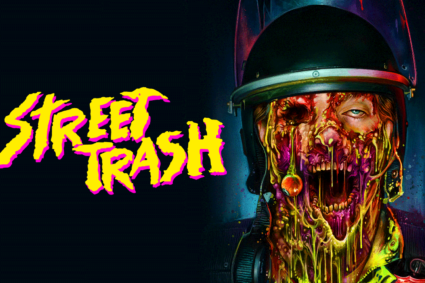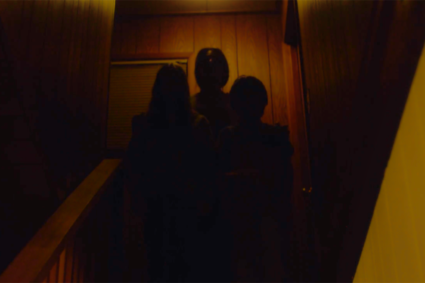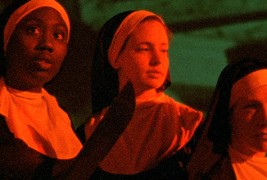
Before we begin this interview let us take a moment to bow our heads down in prayer. If you’re new to the faith of nunsploitation please follow along by using the excerpt of the prayer below.
Nunspolitation prayer:
“Our father in heaven,
unhallowed be those who take vengeance in your name,
(but forgive us because we just don’t care)
Thy kill be done
Thy enemies’ entrails will be undone
When we bless our machetes and AK-47s
And send all fuck bags to hell in pieces
AMEN! (lock and load)”
That unholy interpretation of the Lord’s Prayer was inspired by Greg Hanson and Casey Regan’s nun-spolitation short film Thy Kill Be Done—a 16 minute orgy of blood and bedlam at the hands of three badass nuns out to avenge the death of their monsignor by hunting down the drug peddling scumbags responsible.
Whether or not you’re a fan of grindhouse-style features or the super niche genre of nunspolitation, Thy Kill Be Done has good characters, great gore and a sense of humor. It’s a slow burn, but if you wait for the fuse to reach the detonator you’re going to be rewarded with some explosive scenes, and as far as grindhouse-type flicks go, it’s a short that’s worthy of playing on the nicotine stained movie screens of burned out, dilapidated, midnight movie theaters from the 70’s or present day (and I truly mean that as a compliment).
Co-Writer/Director Greg Hanson from Greth Productions is one of the twisted minds behind Thy Kill Be Done and he’s no stranger to short films and tongue-in-cheek thrills. Ravenous Monster got to chat with him about his experiences creating Thy Kill Be Done and what it’s like working in the indie scene.
RavMon: Tell us about Thy Kill Be Done, its characters and what inspired you to create it.
Greg Hanson: Thy Kill Be Done was a fun project that my co-director Casey and I came up with when we were approached by a few friends that were interested in doing a short “Grindhouse”-style trailer. Casey and I sat around the whole next day while we were on set (it was uneventful, we weren’t being lazy!) and just hashed out an idea. We came up with the idea to shoot a nunsploitation flick because we happened to be sitting across from a small church while we were brainstorming. “What if there are shady dealings in the church and the nuns have to go and kick some ass?!” We exclaimed. We knew we wanted to do a revenge story and we thought it would be fun to mesh that and the more classic eurotrash nunsploitation genre of stuff like Killer Nun.
It took us about an hour to figure that out. The rest of the day was figuring out a good title.
From there, it all snowballed. So much came from us just riffing on bad puns and twists on our favorite exploitation ideas. Stuff like nailgun murders and Vietnam flashbacks came almost immediately. We had a lot of friends who loved everything we were putting down so that inspired us to keep going – trying to think of the most insane things we could throw down in 15 minutes.
What emerged is before you.
RavMon: Your production company, Greth Productions, was founded in 2008 with a few of your colleagues — Seth Applebaum (who did the original music and cinematography for Thy Kill Be Done and several other Greth productions) and Casey Regan—with whom you’ve co-written and directed in the past. Can you give us some examples of what makes you guys a great creative team?
GH: Seth and I work really well together because we have gotten to a point where we’ve worked with each other so much and gotten to know each other so well that we have an unspoken understanding of what we both bring to the table and what we are looking to do. It’s really wonderful. And that’s not to say we don’t sometimes butt heads, but it means that we don’t have to sit down and discuss why an exploitation movie like Thy Kill Be Done should be shot on 16mm instead of HDSLR – he gets it. He gets the crazy colors and the snap zooms. He’s very intuitive with his camera movements, which is great. Sometimes we don’t know that he’s done something like a zoom or a slight move and we’ll watch the dailies and say, “Perfect!”
Casey and I work well together for much the same reasons. Thy Kill was our first big project together but we co-directed a short called Boys Will Be Boys before that and he helped me produce my thesis film Monster of Mad Mooney’s Lake, so we had had experience working together on some films before. Casey and I are great because we are sort of two sides of the same coin. As a writer/director team we essentially take the best traits of both of us as writers and directors and utilize them. And it’s great, especially when you’re prepping an action scene or something where one director can focus on directing the scene at hand while the other works with the fight choreographer or SFX for the upcoming scenes. It makes working on a tight schedule go smoothly.
RavMon: Thy Kill Be Done was started in 2010 along with several other Greth shorts. Where did you begin shooting Thy Kill Be Done?
GH: 2010 was a big year for us–we finished my thesis film Monster of Mad Mooney’s Lake, which we had shot the summer of 2009 on Long Island, where I grew up. We finished that film in May, simultaneous with finishing Thy Kill Be Done, which was crazy because our editor Jamie Kennedy was the editor for both projects, along with fellow Greth film Cinemazing, which she also wrote and directed. I produced that and Seth shot it, Cara was the AD and producer and Doug was the key grip. The films that year were all real Greth family affairs–I think we all worked on all three films in one way or another. It was really fun.
We shot Thy Kill in a weekend in Tewksbury, MA right after winter break–so sometime in late January. This became problematic when we had to shoot night exteriors at three in the morning without a heating tent. Welcome to the land of no-budget filmmaking.
RavMon: What’s your most interesting experience during the course of shooting and producing Thy Kill Be Done?
GH: The most interesting experience while we were making the film probably came during our casting sessions.
We were casting for our three main nuns and we had a woman who came in to audition who had had a lot of experience on her resume. Right before we began the audition, she tied a sweatshirt around her head like a habit, we asked her a few questions and she told us that she, “Used to be a nun.” We thought, “Wow! That’s great!” But what we later learned was that she WAS a nun and NOW she is a missionary. And she hadn’t read the sides. So, she had no idea what the film was, all she knew was that it was about nuns. She read it and kept stopping and amending the lines. Being a missionary and an ex-nun, she felt she had to let us know that nuns don’t curse the way they do in the film. Or kill people. In fact, they don’t act violently at all. And no, she didn’t know who Quentin Tarantino was, but she WOULD perhaps help us rewrite the script if the “Almighty” said it was okay. Then she left. And we lost our shit.
RavMon: That’s awesome. One of my favorite scenes in the movie is one depicting the nuns’ Vietnam flashback which shows that they’re no strangers to violence. What’s your favorite scene and why?
GH: I think the ‘Nam flashback is the most effective scene in the film. It is where the film switches gears and goes into a crazier direction. It’s the place where everyone collectively realizes they are watching a film that isn’t trying to be dour, it’s trying to be raucous and fun and bizarre and all the wonderful things that exploitation movies can be. I also think it was our most precise scene–and it had to be because if it wasn’t, it would have fallen really flat.
I am also really partial to the final showdown sequence at the end. I really love our location and the way we covered the action. To be honest, asking me what scene is my favorite is like asking what’s my favorite child? We tried to make each scene have something fun and pulpy and interesting–like I love the bar scene because of how tough our women are and how intense Jess (Sister Yvonne) is. I also love Corey who played our Jesus figure. He just really nailed it. Get it?
RavMon: What are the pros and cons of making independent films?
GH: I love watching independent films and I love making them. The cons about them are typically the lack of budget, time, and resources. You really have to make up for the lack of finances by putting in a lot of extra time and elbow grease. I typically write, produce, and direct (with lots of help, of course) and can sometimes do as much as editing, sound design, makeup effects, set up lights, hold boom, and act in the damn thing! It’s definitely not the sort of situation where everyone only does one thing, as the Unions would.
But the pros are so much better. You have creative control and that is maybe the most important thing. Even if you don’t have total creative control, you probably have a lot less people to answer to. Independent films can be funny, daring, bizarre, off-kilter without even getting out of the first ten minutes. You can really push boundaries and make people uncomfortable. Independent films, or at least the good ones, are fearless. And they have to be–making a tepid, middle-of-the-road independent film just falls flat. You have to go for the gusto! And you can!
For me, I love making independent films because it’s so much fun. You can run the set the way you want to, you can hack off as many limbs as you want to, make it as weird as you want to. The community is just amazing and people are so supportive. Your lack of money gives way to a lot of amazing invention – figuring out ways to do the things you want for little or nothing. That’s just a blast (continued after the pic).
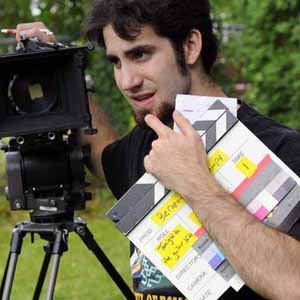
RavMon: What’s it like being part of the digital revolution in the indie scene?
GH: Being part of the digital revolution has been interesting, especially because we have chosen to ignore it for so long. When people were getting excited about shooting on the RED, we were still very into shooting on S16mm. And we still are. The nice thing about digital, obviously, is that we can go out and shoot a fun project for next to nothing. What’s really great is that now we have the pick of the litter. If we don’t have a lot of money – we never do, but it’s all relative – then we can shoot digital, and if we really feel like shelling out a few extra dollars, we can shoot on film.
What is cool, though, is how the digital revolution, for better or worse, has given voice to many artists who wouldn’t have been able to make films before. This creates an interesting landscape, it’s kind of like punk rock. There might be more crap out there now but there are definitely plenty of diamonds. I personally think one of the coolest things is that as a short filmmaker, the advent of digital has made film festival submissions a lot less of a hassle. Sending out a Vimeo link is a lot easier and more cost effective and greener than sending out DVDs all the time.
RavMon: Has Thy Kill Be Done or any other Greth production played the festival circuit? If so what were those experiences like, and how was the audience reaction?
GH: Thy Kill Be Done has had a really great festival life. It was the first film that I really sent out for a proper festival run and it has played almost 30 festivals and continues to play every so often. It’s going down to Corpus Christi, TX soon for the South Texas Underground Film Festival and to Berlin for the Berliner Trash Film Festival, both in September.
My favorite experience was when I thought it was done with its festival run last summer. It had played for about a year on the circuit and it had played some wonderful festivals like Boston Underground, Arizona Underground, Coney Island, etc. And then we got accepted to the Sitges Fantastic Film Festival, which is the largest genre festival in the world. I nearly leaped out of my skin.
So, of course I went. We were opening for Hobo with a Shotgun in this all-night marathon program where Jason Eisener and Michael Biehn were there and we were screening in this huge 1200-seat theater that was teeming with people. And after we screened, Jason just looked over at me and said, “Hell yeah, dude!” It was a really gratifying experience.
RavMon: Are there any festivals you haven’t played yet that you really want to play?
GH: I feel really fortunate that our films have been able to play so many wonderful festivals. We haven’t yet screened at Fantastic Fest and I think that would be a real blast. I love Austin and the Drafthouse and their audience is just killer.
I would also love to play the Lund Fantastic Film Festival in Sweden. I have friends that have been there and said that it’s just amazing. The people who run it are wonderful and apparently make every effort to make your stay wonderful and really include everybody. It’s a great way to meet and hang out with a ton of great people and see some amazing films.
RavMon: As a nunsploitation film, Thy Kill Be Done has a gritty, grindhouse, retro look and feel. What are some of your influences from the exploitation era?
GH: We were heavily influenced by a whole bunch of stuff like Jack Hill’s Switchblade Sisters and Coffy, Death Wish, Faster Pussycat, Kill Kill! We were looking at stuff like Sonny Chiba’s The Street Fighter and Master of the Flying Guillotine (as referenced in the film), and obviously stuff like Killer Nun and the hilarious Demonia. We watched a whole bunch of stuff and tried to incorporate some non-exploitation era filmmaking devices (rear projection, anyone?).
RavMon: What would happen if you had unlimited funds, your pick of any cast and crew (dead or alive), any genre, and any concept…in other words, what would be your ultimate dream picture?
GH: I had this amazing dream cast that I have been working on but unfortunately, over the last few years, some of my favorites have passed away. I really wish I had had a chance to work with some of the greats like David Carradine and Dennis Hopper.
If I had my way, though, I would make a crazy mash-up of my favorite things. It would be like the Casablanca of genre films–not in that it would the best, but in that it would have a little something for everyone. I would want it to be part classic horror film, part action-exploitation, part dark comedy, part absurd arthouse. Like if Russ Meyer, George Romero, Seijun Suzuki, and Jack Hill were thrown in a blender and served with some creme fraiche and a cockroach. Sweet-yet-disgusting.
I would definitely want to get people like Jeff Goldblum, Bill Moseley, Dick Miller, Michael Shannon, and Harry Dean Stanton. I would love to continue to work with my stable, though, and actually be able to pay them for a good days’ work. I love my actors and really if I had my way, I would be able to spend a lot of time with them and really knock everything out of the park. Plus, I would definitely kill a lot of people. I don’t know what this film would look like but it would surely be something special. Maybe the bad kind of special.
RavMon: Like most indie filmmakers, you seem multi-talented and multi-faceted. Aside from Thy Kill Be Done, you’ve directed dozens of shorts. What draws you to doing short films? What do you feel are the pros and cons of doing short films?
GH: The short form is great. I just love making films and being creative. I am a storyteller in my heart, so everything I do has a story in some sense. I am in many ways a workaholic and I love to keep busy. The great thing about the short form is the challenge of trying to keep everything concise. Some stories just don’t warrant being an hour and a half and those stories are just as interesting and fun to create. Take one of our latest shorts, Sink Hole, for example. It’s about a guy who gets lured into a sexual tryst by his talking sink. It’s a minute and a half long. It didn’t need to be any longer, so it wasn’t.
I also love that you don’t necessarily make your entire life about the film. Shooting is typically short and although it still takes a while to write it and finish it, you can do it while holding down a job (as I have done). For me at this point, it’s a lot of experimentation: Trying out different techniques, different genres, different styles of filmmaking to see what works and what doesn’t so that when I do make that feature, it’ll really blow people out of the water.
The major drawback with shorts is that honestly very few people care or pay attention. It’s a really hard sell to get people to take you seriously as a filmmaker if you have only done short work because it seems easy to many people. A lot of film festivals don’t care about shorts and short filmmakers. For me, though, it ends up being about turning those things around to be to your advantage. Take people by surprise–make them notice you. I have met a ton of people at these wonderful film festivals and I have made a lot of amazing connections. I love that you can sort of crank out shorts–for instance, I met someone at a festival with one short and then saw him again eight months later when I was premiering a new short.
I would love to really dive into something longer and do a really kick ass feature, but for now, we are in the development and writing stages on that end and until then, I will keep making shorts, music videos, and promos to keep me creative and trying to spread the craziness around.
RavMon: What new projects can we expect coming from Greth in the near future? Any feature-length films, or a DVD collection of your recent short films in your plans? Tell us more about your upcoming family cannibal short: Meat Me in Plainville.
GH: Meat Me in Plainville has been a whirlwind project. It follows a father trying to reconnect with his teenage daughter as their small suburban town goes crazy with cannibalism. Casey and I sat down and hashed out this idea that started as the premise of a family drama set in an alternate past that starts where Soylent Green ends. Wrap your mind around that! It is a unique project for us because we really tried to take it in a direction we hadn’t gone and really experiment with both aesthetics and emotional storytelling. It is definitely a horror film but we wanted to make sure that the audience really feels for the characters and that it follows a strong emotional story that is set in motion and fueled by the horror elements.
Meat Me in Plainville and Sink Hole are our two newest shorts. Sink Hole premiered in March and I just came back from premiering Plainville in South Korea at the legendary Puchon International Fantastic Film Festival (or PiFan), which was amazing! So hopefully they will continue to play and have a wonderful life of their own.
We have a new short called Ipecac that is about a gambling addict who finds out he can cough up money and we are trying to finish in time for the fall festival submission season.
We have no plans for a shorts DVD as of yet but perhaps in the future. In the meantime, we are going to release our films to the general public on Vimeo after a healthy festival run!
What else is coming up? We like to keep busy, so we have a slew of fun projects coming out from music videos to promos, shorts, and features. We have screwed up families, feudal dojos, trash worlds, mud people, post-apocalyptic pimps and a ton more. It should be a lot of fun.
RavMon: Where can people find/watch/or get a copies of Thy Kill Be Done and other Greth Productions features?
GH: People can check out some of our films on our website, Grethproductions.com, or our Vimeo. Thy Kill Be Done can be seen here, and our other films will be online shortly or you can catch them at a film festival near you! (Or send grethproductions@gmail.com an email and we can arrange something more…personal…).
RavMon: You heard the man! Check out the links above and watch Thy Kill Be Done. If you go to church or pass nun on the street, this film might make you think twice about the women of God and what they could be packing under those black robes along with their crosses and bibles.


